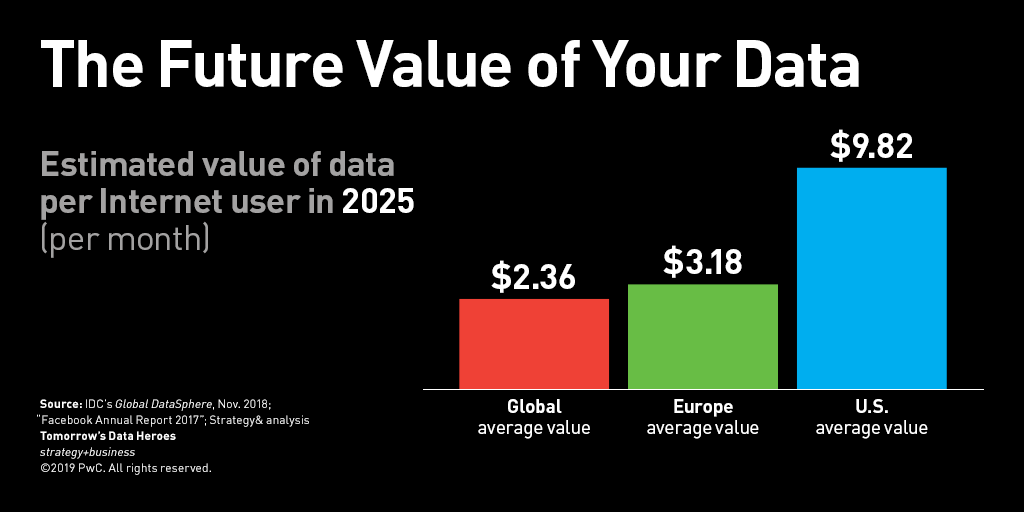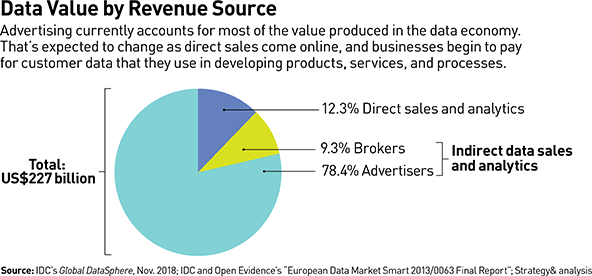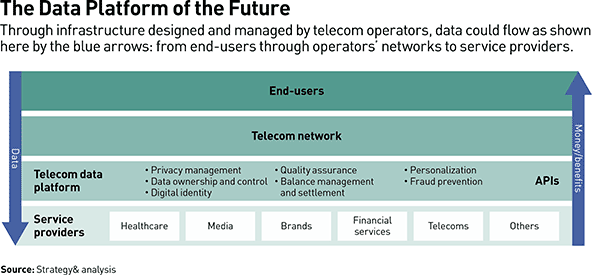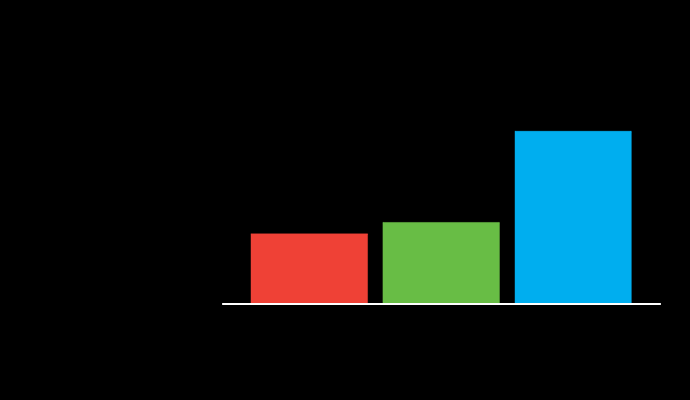Tomorrow’s data heroes
Telecom companies are struggling to find a profitable identity in today’s digital sphere. What about helping customers control their information?
By 2025, Alex had had enough. There no longer seemed to be any distinction between her analog and digital lives. Everywhere she went, every purchase she completed, and just about every move she made, from exercising at the gym to idly surfing the Web, triggered a vast flow of data. That in turn meant she was bombarded with personalized advertising messages, targeted more and more eerily to her. As she walked down the street, messages appeared on her phone about the stores she was passing. Ads popped up on her all-purpose tablet–computer–phone pushing drugs for minor health problems she didn’t know she had — until the symptoms appeared the next day. Worse, she had recently learned that she was being reassigned at work. An AI machine had mastered her current job by analyzing her use of the firm’s productivity software.
It was as if the algorithms of global companies knew more about her than she knew herself — and they probably did. How was it that her every action and conversation, even her thoughts, added to the store of data held about her? After all, it was her data: her preferences, dislikes, interests, friendships, consumer choices, activities, and whereabouts — her very identity — that was being collected, analyzed, profited from, and even used to manage her. All these companies seemed to be making money buying and selling this information. Why shouldn’t she gain some control over the data she generated, and maybe earn some cash by selling it to the companies that had long collected it free of charge?
So Alex signed up for the “personal data manager,” a new service that promised to give her control over her privacy and identity. It was offered by her U.S.-based connectivity company (in this article, we’ll call it DigiLife, but it could be one of many former telephone companies providing Internet services in 2025). During the previous few years, DigiLife had transformed itself into a connectivity hub: a platform that made it easier for customers to join, manage, and track interactions with media and software entities across the online world. Thanks to recently passed laws regarding digital identity and data management, including the “right to be forgotten,” the DigiLife data manager was more than window dressing. It laid out easy-to-follow choices that all Web-based service providers were required by law to honor.
First, prompted by the new service, Alex requested that the data that companies had already accumulated about her be deleted, so that she could begin with a clean slate. Then she signed onto DigiLife’s data-management app, which acted as a gatekeeper for all the information that from now on would pass from her connected devices to the Internet.
The app offered Alex choices about how much she would be willing to reveal to companies, service providers, and other organizations. Powered by an artificial intelligence system that used her customer profile to effectively predict her needs and intentions, the app made it easy to choose different levels of privacy and openness for each site, and to estimate the monetary value of the data she generated.
Alex chose, for example, to allow a few selected e-commerce and financial-services companies to gain access to her identity authentication data, so she could make purchases and bank online. But she prevented them from accessing her location or combining her shopping data with that from other firms. She allowed location information generated by her mobile phone to be revealed to the provider of her mapping app and to send data from her fitness-tracking wristband to her doctor, but not to her insurance company. Finally, she allowed a few e-commerce companies, social media sites, insurance companies, drugmakers, and others to collect data on her interests, preferences, and lifestyle choices. In exchange, each of them offered her a financial incentive, such as discounts on her car and health insurance or micropayments returned to her DigiLife billing account. Over the following months, Alex found herself returning to the app frequently to add new websites and refine her personal data settings.
Today, in 2019, personal data management applications like the one Alex used exist only in nascent form, and consumers have yet to demonstrate that they trust these services. Nor can they yet profit by selling their data. But the need is great, and so is the opportunity for companies that fulfill it. By 2025, the total value of the data economy as currently structured will rise to more than US$400 billion, and by monetizing the vast amounts of data they produce, consumers can potentially recapture as much as a quarter of that total.
By 2025, the total value of the data economy will rise to more than US$400 billion, and by monetizing the vast amounts of data they produce, consumers can recapture as much as a quarter of that total.
Given the critical role of telecom operating companies within the digital economy — the central position of their data networks, their networking capabilities, their customer relationships, and their experience in government affairs — they are in a good position to seize this business opportunity. They might not do it alone; they are likely to form consortia with software companies or other digital partners. Nonetheless, for legacy connectivity companies, providing this type of service may be the most sustainable business option. It may also be the best option for the rest of us, as we try to maintain control in a digital world flooded with our personal data.
Estimating Data’s Value
A look at the numbers shows just how large — and profitable — the data economy has grown in recent years, and how much faster it will grow in the years ahead. In 2018, according to the International Data Corporation (IDC) (pdf), the world generated 33 zettabytes of data from all sources, up from 4.4 zettabytes just five years earlier. That’s a compound annual growth rate of 50 percent, and this ocean of information is expected to increase to 175 zettabytes by 2025, more than five times what it was in 2018. (A zettabyte is a billion terabytes, or 1021 bytes; data scientist Riza Berkan estimates that a zettabyte stored in printed books would require a stack reaching to the sun and back five times.)
The vast majority of data interactions take place among machines — many of them online, but a growing number through the Internet of Things (IoT). To be sure, most data is stored for only a few milliseconds before being discarded. Nonetheless, about 3.7 zettabytes of data generated by people — an average of about 117 gigabytes of data per Internet user — is stored per year. About 25 percent of that is stored by Google (by far the largest percentage of user data stored by any single company), and another 1 percent by Facebook. By 2025, average data generation per person is expected to reach almost 300 gigabytes. A Seagate-sponsored IDC report (pdf) estimates that the average person will thus produce more than 4,900 data interactions per day, or one datum every 18 seconds, about 20 percent of them critical to daily life. About 90 percent of this data will be vulnerable to unauthorized capture or cyber theft, yet less than half of it will be secured.
It’s mind-boggling to consider the sheer extent and granularity of all the data stored and analyzed in this huge, rapidly-growing global algorithmic ecosystem after just its first two decades of existence. Moreover, we estimate that this information, combined with current analytics, creates close to a quarter of a trillion dollars in economic value each year. None of this value accrues to the individuals whose activity is the source of the data. Companies that use personal data to enable targeted advertising (Google, Facebook, and other social media and search firms) earned about $178 billion in revenue in 2018; data brokers brought in about $21 billion; and corporations (such as telecom operators, payment companies, and carmakers) that use consumer data to increase their own value generated another $28 billion (shown as “direct sales and analytics” in “Data Value by Revenue Source”).
Currently, value creation in the data economy is driven overwhelmingly by online advertising, which generated almost 80 percent of the online sector’s revenue in 2018 — with most of it going to Google and Facebook. In time, however, advertising’s proportion of value creation will decline. Once virtually all advertising goes digital, its growth will reach a limit, no matter how well targeted it becomes. And the data brokers will struggle to sell personal information once regulatory limits are placed on its dissemination and users begin to curtail its collection.
Instead, growth will likely come from direct sales to enterprises such as auto makers, retailers, payment companies, and telecom operators, all seeking to improve their sales and operations. Once a viable commercial data ecosystem is created through which all players, including service providers and users, can sell, buy, trade, and profit from data, the conditions will be in place for a new type of data-based economy. It will encompass a range of novel services, some in current fields like healthcare, banking, insurance, media, and entertainment, and others that are still unimagined.
How much is a user’s data worth? According to our analysis, the average Internet user’s personal data is currently valued at about $1.18 a month, and as much as $4.91 a month in the U.S., where the online advertising market is far larger than elsewhere. For example, people willing to install a telematics device in their car and thus provide real-time driving data to their auto insurance company — and demonstrate that they drive safely, of course — can get discounts of up to 50 percent on their car insurance. As the full data ecosystem comes into being, the value of consumer behavioral data will likely grow higher. Insurance, healthcare, and e-commerce companies, among others, will aggregate their customer data and use it to operate more efficiently and launch new products and services more successfully. This alone could be worth several hundred dollars a year to an individual in lower prices or outright payments (see “The Future Value of Your Data”).


Given the massive size and complexity of the data economy, it’s a wonder it works at all. Yet it does, for the most part. “User Needs in the Data Economy” lays out the specific rights and needs of both end-users and service providers in six key areas: privacy, security, authentication, data ownership, relevance, and frictionless experiences. Users’ expectations for greater privacy, and for transparency into how the data they generate is being used, will increase over time, while companies collecting, analyzing, and selling personal data will probably be forced to meet ever more stringent privacy regulations.
As an example of the way in which telecom operators could seize an opportunity to help improve privacy, consider the standards called STIR/SHAKEN (Secure Telephone Identity Revisited/Signature-based Handling of Asserted information using toKENs), which describe a cryptographic system for verifying incoming phone numbers and thus reducing the irritation of robocalls. Introduced in 2019 in the U.S., STIR/SHAKEN requires participating companies to join a common governance system that would certify legitimate callers, and it could become a prototype for verification and privacy-protection systems used by connectivity companies in the future.
Users will also demand simpler systems, likely incorporating blockchain technology, for proving who they are online. This will replace the welter of user names and passwords they rely on now. Artificial intelligence and machine learning systems will help provide referrals and access to websites, and help determine the optimal level of Internet service quality, bandwidth, throughput, latency, and security for each user. The kinds of connectivity demanded by users in the dawning 5G world will depend on the activity in which they are engaged.
Some data companies are trying to address one or more of these needs, but no one has managed to address all of them. Perhaps the closest current example is Verimi, a cross-industry identity and data service that provides users with a single sign-on to a variety of services. Launched in Germany in May 2018, Verimi allows end-users to decide which providers can access which data. Partners include Allianz, Axel Springer, Daimler, Deutsche Telekom, and Lufthansa.
A number of smaller firms and startups are getting into the act too. One example is Solid. Founded in 2015 by Tim Berners-Lee, who developed the World Wide Web protocol in 1989, Solid is an attempt to “re-decentralize” the Web by enabling users to maintain their own data in “pods,” on their own computers or in the cloud. Users choose which apps and websites get access to their personal data.
Similarly, Datum, founded in 2017 and based in Hong Kong, is trying to create a marketplace where users can share or sell data on their own terms. Its database, backed up by a blockchain ledger, allows people to store duplicate copies of their social network data, data from wearables, and smart-home and other IoT devices securely, privately, and anonymously.
The Role for Telecom
The opportunity for telecom operators lies in helping customers manage their Internet experience, including their privacy and connectivity rights. Telecom’s role in the new data economy is grounded in operators’ core networking and connectivity capabilities, their central position as the carriers of all digital traffic, and their large customer constituencies. Already, many telecom leaders are determined to enrich their core operations, enabling them to gain value where they have a natural and unique right to play.
Consider the range of telecom company assets that are deeply relevant to the data economy:
Networks. Physical infrastructure is still essential to digital communication — and could be a more powerful asset in the future. Telecom networks are rapidly increasing in coverage, capacity, and capabilities. The move to high-speed 5G mobile technology, expected to launch in 2020, will enable telecom operators to collect more customer data — with the consent of users — and position them to be critical enablers of connected experiences. However, operators are generally local; they will have to team with other players to extend their influence beyond their home markets and build global coverage.
Customer data. Although telecom operators do not currently have access to the many kinds of personal data that flow among users and service providers, they do maintain a great deal of critical data about customers. They have access to large customer bases within their markets and to data related to users’ bills and payments, their street addresses, and their phone numbers and email access points. At the network level, telecoms can track the location of users based on the radio access networks used for mobile telephony. They can tie every device owned by every user to a specific account, giving them visibility into device-level information. This allows them to manage authentication in the background, for example, rather than rely on SMS tokens. And they can use this data to gain insight into social interactions, demographic trends, and community dynamics.
Brands and customer relationships. Although consumer attitudes toward local operators vary significantly by market, in general, customers trust telecoms to handle their data securely. Large operators are well established in their respective markets, with strong brand awareness and, in many cases, links to local governments. And they have experienced few if any security breaches in recent years, especially compared with many over-the-top (OTT) players.
Regulatory capabilities. Unlike potential competitors such as OTT companies, telecom operators are already heavily regulated, with the necessary protocols in place to conform to regulators’ expectations. They can build on that position to gain a competitive advantage by providing “regulator-certified trust” to users and service providers alike. Their well-established teams of lobbyists and regulatory affairs specialists can help them navigate the government-related challenges and opportunities that will inevitably come their way.
Building the Data Platform
These critical assets should allow operators to build the key feature of their data-economy play — the data platform that will allow both end-users and data-enabled service providers to conduct their online activities privately and securely, and to make choices about whom they would release their personal data to, and on what terms (see “The Data Platform of the Future”).
Currently, telecom networks act primarily as “dumb pipes,” passively enabling the exchange of data between users and providers. Each provider must negotiate its own identity, transaction, and personalization relationship with each user.
The data platform changes all that. It would consist of a collection of features covering the many data needs of users and the online companies they interact with, including privacy, security, and identity management, and the software and apps that would allow users to take ownership of and monetize the data they produce. It would enable operators and other service providers connected to the system, such as healthcare, financial-services, and media companies, to connect to users’ data platforms to offer their services. Consumers would then use the app to manage all the connections to the individual service providers.
This is what the industry calls a B2B2C play. On one end of the ecosystem, operators setting up the system would contract with service providers. On the other end, they attract consumers. The success of the system will depend largely on trust. Consumers must be convinced that the platform will be consistently accessible, reliable, and safe to use, while service providers would join to gain access to those consumers, and to burnish their brand reputation for trustworthiness.
Aside from the technical requirements of building such a platform, operators looking to follow this path must develop two other key capabilities — partnering and government affairs.
Partnering. Implementing the data platform will require working together with other network operators and a range of service providers in various industries. Some of the partnering companies would seek scale together. For example, local telecoms would work with other local and international fixed, mobile, and cable providers to offer the greatest possible coverage for their data platforms. Other partnerships would be oriented toward value, and success would depend largely on the kinds of services offered. In creating these partnerships, telecoms would have to overcome a variety of challenges, such as antitrust issues, strategic misalignment, technology and network integration hurdles, different views on the pace of change needed, their own risk-averse cultures, and the difficulty of recruiting skilled talent. Successful partnerships would overcome these challenges by fostering open innovation and more diligent collaboration.
Government affairs. The creation of data platforms will also require operators to seek a stronger political role: influencing the public policies and regulations that might otherwise hold back the launch of a full commercial data ecosystem. Operators will have to lobby for a comprehensive set of digital rights, including the “right to a digital identity” and the “right to be forgotten.” Currently, most jurisdictions do not have a defined set of digital rights (beyond access to connectivity in some countries and certain privacy regulations in others). They will also have to push for stricter regulations governing how companies collect, use, and resell personal data, and requiring greater visibility into their data-oriented activities. And they will likely need to promote rules regarding fair competition among companies that maintain large quantities of personal data.
The Core of the Opportunity
Consumers, service providers, and operators alike have a significant opportunity to shape behavior on the new data platforms. Some users will choose settings that almost entirely restrict the flow of their personal data. They will allow only the bare minimum of identity authentication data to be shared online — generally with the banks and e-commerce companies who regularly do business with them.
Other people will be freer with their data, knowing that they will get something of value in return. E-commerce companies might offer better deals to customers who are willing to let them collect and sell data on their buying habits. Consumers will also sell companies the right to track their activity and use it in banks of anonymized data. Since most Internet users will generate thousands of data points a day by 2025, they will have a considerable hoard of data to sell.
Telecom companies could function much like credit card companies do now, taking a small commission on every transaction between consumers on their platform and their partner service providers. They could offer their own AI-driven predictive analysis of user data to their business partners. Or they could offer a variety of fee-based services to consumers and businesses alike: fraud protection, digital privacy control, ID authentication, digital transaction assurance, and predictive analytics for participating service providers. Eventually, telecoms could even consider offering personalized curation of digital experiences such as content, apps, ads, and e-commerce deals for consumers.
To be sure, telecom operators have not typically been technological leaders in the past. It will require a significant cultural shift to capture this opportunity. But those that begin moving in this direction will likely see a viable path to growth open up before them, with all of the value and reputational gain that come from being a trusted and transparent partner to customers, and giving them access to and control of the digital world.
Author profiles:
- Florian Gröne is an advisor to executives in the telecommunications, digital, and software sectors for Strategy&, PwC’s strategy consulting group. Based in New York, he is a principal with PwC US. He helps companies develop business and technology strategies for the digital era.
- Pierre Péladeau is a leading practitioner for Strategy& in the telecommunications and high-tech sectors, and in digital transformations. Based in Paris, he is a partner with PwC France. He supports executives working on digital strategy in the telecommunications, technology, energy, utilities, aerospace, and retail sectors.
- Rawia Abdel Samad is a manager with Strategy& based in Boston. She works with the technology and media sectors and advises companies on growth and technology strategies for the digital era.
- Also contributing to this article is Strategy& thought leader Samer Kallas, who is a director with PwC France.






